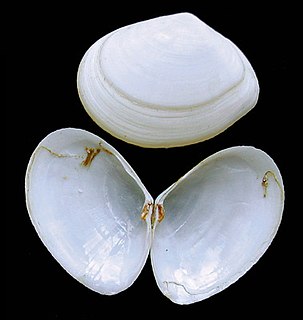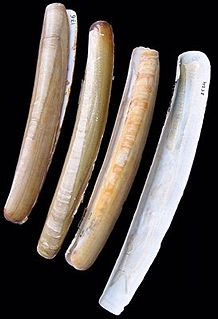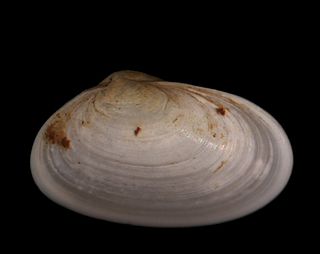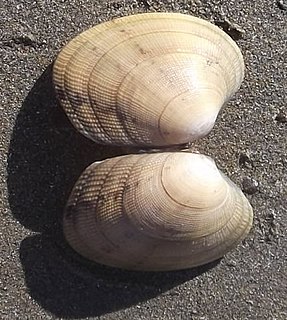
Bivalvia, in previous centuries referred to as the Lamellibranchiata and Pelecypoda, is a class of marine and freshwater molluscs that have laterally compressed bodies enclosed by a shell consisting of two hinged parts. Bivalves as a group have no head and they lack some usual molluscan organs like the radula and the odontophore. They include the clams, oysters, cockles, mussels, scallops, and numerous other families that live in saltwater, as well as a number of families that live in freshwater. The majority are filter feeders. The gills have evolved into ctenidia, specialised organs for feeding and breathing. Most bivalves bury themselves in sediment where they are relatively safe from predation. Others lie on the sea floor or attach themselves to rocks or other hard surfaces. Some bivalves, such as the scallops and file shells, can swim. The shipworms bore into wood, clay, or stone and live inside these substances.
Poromyidae is a family of saltwater clams, marine bivalve molluscs in the order Anomalodesmata. The genus Dilemma, described in 2008, is remarkable for being a predator of copepods, which is very unusual for a sessile mollusc.

A bivalve shell is part of the body, the exoskeleton or shell, of a bivalve mollusk. In life, the shell of this class of mollusks is composed of two hinged parts or valves. Bivalves are very common in essentially all aquatic locales, including saltwater, brackish water, and freshwater. The shells of bivalves commonly wash up on beaches and along the edges of lakes, rivers, and streams. Bivalves by definition possess two shells or valves, a "right valve" and a "left valve", that are joined by a ligament. The two valves usually articulate with one another using structures known as "teeth" which are situated along the hinge line. In many bivalve shells, the two valves are symmetrical along the hinge line—when truly symmetrical, such an animal is said to be equivalved; if the valves vary from each other in size or shape, inequivalved. If symmetrical front-to-back, the valves are said to be equilateral, and are otherwise considered inequilateral.

Anodontia alba, or the buttercup lucine, is a species of bivalve mollusc in the family Lucinidae. It can be found along the Atlantic coast of North America, its range extending from North Carolina in the United States to the West Indies.

Codakia orbicularis, or the tiger lucine, is a species of bivalve mollusc in the family Lucinidae. It can be found along the Atlantic coast of North America, ranging from Florida to the West Indies.

Ensis ensis, or the sword razor, is a razor clam, a marine bivalve mollusc in the family Pharidae. It lives buried in the sand and is found off the coasts of northwest Europe.

Fabulina fabula, the bean-like tellin, is a species of marine bivalve mollusc in the family Tellinidae. It is found off the coasts of northwest Europe, where it lives buried in sandy sediments.

Tellina tenuis, the thin tellin, is a species of marine bivalve mollusc in the family Tellinidae. It is found off the coasts of northwest Europe and in the Mediterranean Sea, where it lives buried in sandy sediments.

Tellimya ferruginosa is a species of small marine bivalve mollusc in the family Lasaeidae. It is found on the eastern side of the Atlantic Ocean.

Abra alba, or the white furrow shell, is a species of bivalve mollusc in the family Semelidae. It occurs in the northeastern Atlantic Ocean and the Mediterranean Sea, where it lives on the floor in shallow areas buried in soft sediments.
Phaxas pellucidus, the transparent razor shell, is a species of marine bivalve mollusc in the family Pharidae. It is found buried in the seabed in coastal waters of northwest Europe, often in great numbers.

Lutraria lutraria is a species of large marine bivalve mollusc in the family Mactridae. Its common names include the otter shell and the common otter shell. It occurs in coastal regions of the north east Atlantic Ocean where it lives buried in the sand.

Venerupis decussata is a marine bivalve mollusc in the family Veneridae, commonly known as the cross-cut carpet shell.

Cyrtopleura costata, or the angel wing clam, is a bivalve mollusc in the family Pholadidae. It is found in shallow parts of the northwest Atlantic and also in the North Sea of Scotland coastline and west coast of the Adriatic Sea by a remote area in the Marche region in central Italy, living in the seabed, where it digs its burrows on a very slow revolving movement for years through soft sand and mud always to a max depth of 8ft but always below 3 feet (0.91 m) at the lowest tide.

Donax vittatus, or the banded wedge shell, is a species of bivalve mollusc in the order Cardiida. It is found on beaches in northwest Europe buried in the sand on the lower shore.

Mulinia lateralis, the dwarf surf clam or coot clam, is a species of small saltwater clam, a bivalve mollusc in the family Mactridae. It occurs in the western Atlantic Ocean and the Caribbean Sea.

Venerupis corrugata, the pullet carpet shell, is a species of bivalve mollusc in the family Veneridae. It is found buried in the sediment on the sea bed in shallow parts of the eastern Atlantic Ocean. It is harvested for human consumption in Spain and other parts of Western Europe.

Hinge teeth are part of the anatomical structure of the inner surface of a bivalve shell, i.e. the shell of a bivalve mollusk. Bivalves by definition have two valves, which are joined together by a strong and flexible ligament situated on the hinge line at the dorsal edge of the shell. In life, the shell needs to be able to open slightly to allow the foot and siphons to protrude, and then close again, without the valves moving out of alignment with one another. To make this possible, in most cases the two valves are articulated using an arrangement of structures known as hinge teeth. Like the ligament, the hinge teeth are also situated along the hinge line of the shell.

Glossus humanus, the oxheart clam, is a species of species of marine clam found in deepwater off the Atlantic coastline of Europe and Northern Africa. It is the only remaining extant species in the genus Glossus.

Pharus legumen, is a species of bivalve mollusc commonly found burrowed in the sand on lower shores and in the shallow sublittoral.

















